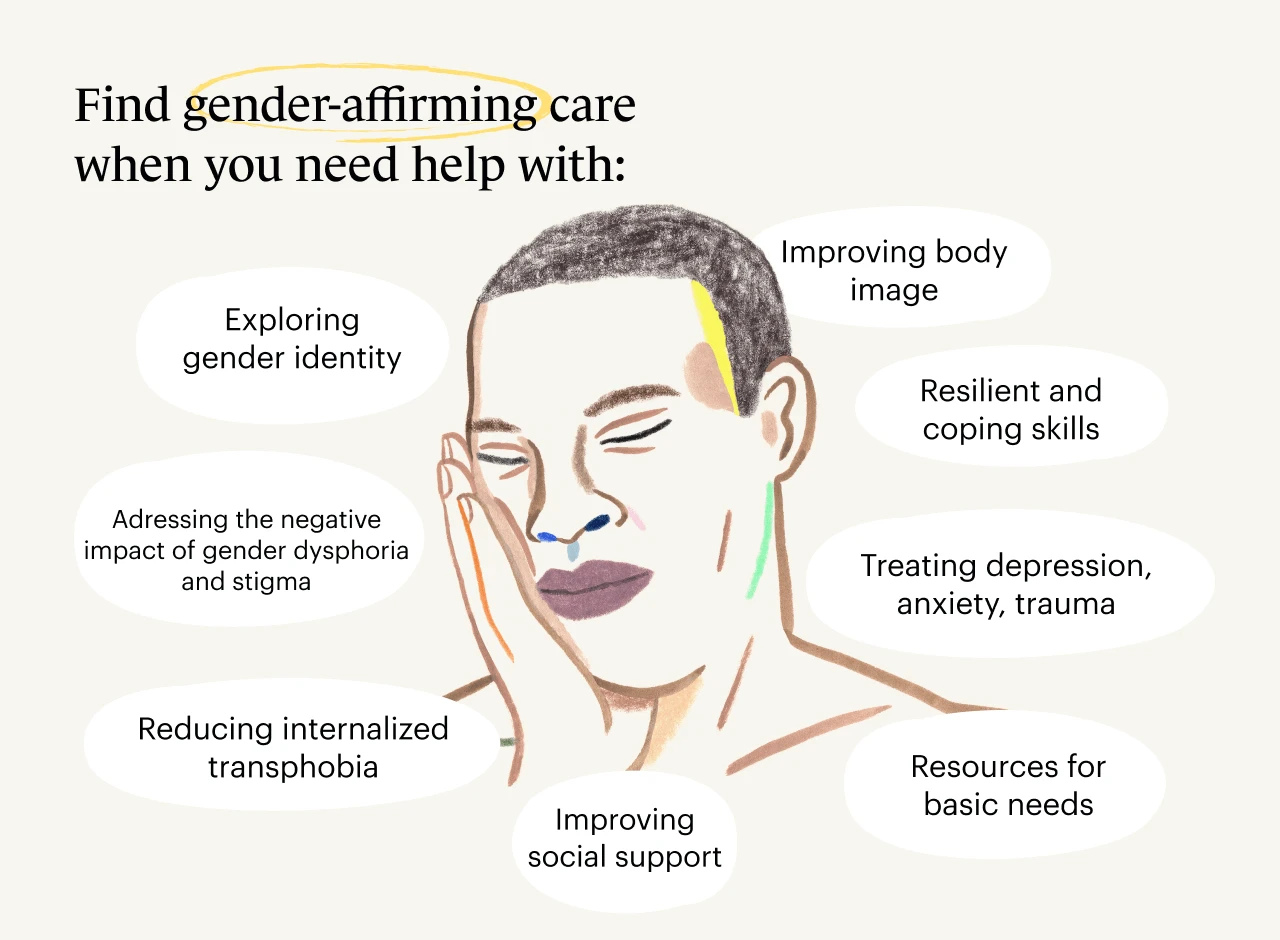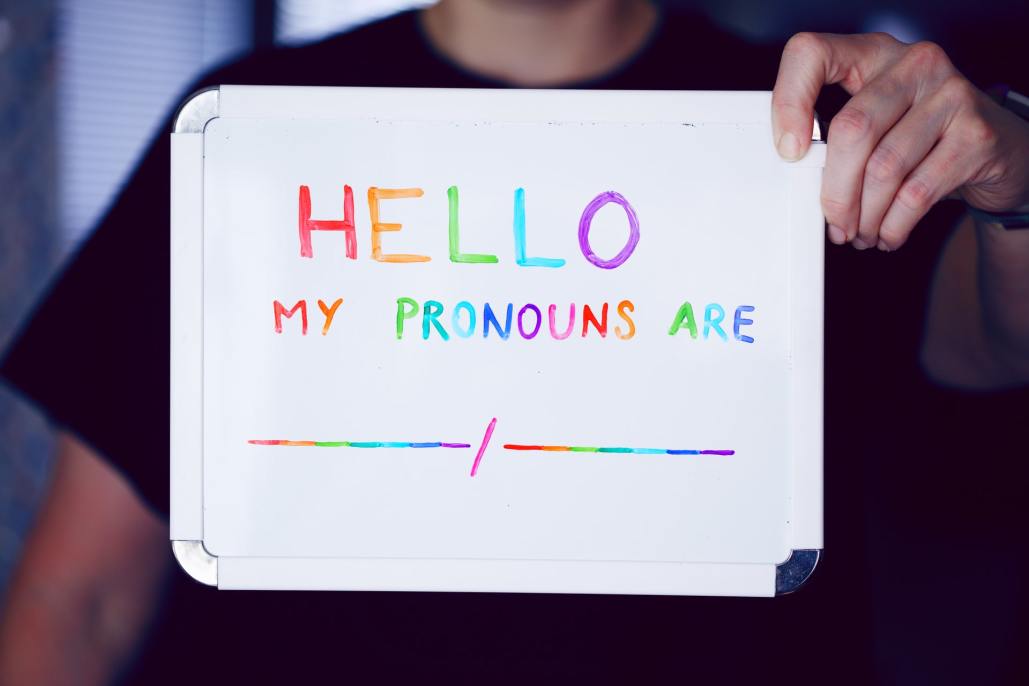“I knew something wasn’t right, but I didn’t have a name for it."
I’ve heard this sentence so many times from gender-diverse and trans therapy clients experiencing gender dysphoria.
Gender dysphoria can feel overwhelming and uncomfortable.
It's the experience that the sex someone was assigned at birth is not aligned with their gender identity.
You have a right to congruence between your body and your gender identity.
Understand that you’re not alone.
While it can be a relief to connect with members of the trans community and the LGBTQIA+ community, it can also unleash a flood of anxiety that can be summed up with: What now?
You have a right to congruence between your body and your gender identity.
There is help and support available, including trans-affirming therapists and therapists experienced with clients who identify as LGBTQIA+.

How many people have gender dysphoria?
According to a 2016 report by the Williams Institute at UCLA School of Law, about 1.4 million American adults identify as transgender—that’s approximately .6% of the population.
Hawaii, California, Georgia, New Mexico, Texas, and Florida have the highest percentages of adults who identify as trans.
Although some people seem to perceive it as such, being trans or gender-diverse is not a new phenomenon.
That said, it’s important to take note that not everyone who identifies as transgender has gender dysphoria. (More on this below.)
What does it mean to be a gender-diverse child, teen, or adult?
The term gender diversity, as used by New Zealand’s Health Navigator, is a term to cover “the range of possible gender identities, such as female, male, transgender, intersex, non-binary and takatāapui."
Gender-diverse is an umbrella term that includes those who don’t place themselves in the male/female binary, such as those who define as genderqueer, genderfluid, and nonbinary.
Gender dysphoria is not a new term nor a new concept.
Although some people seem to perceive it as such, being trans or gender-diverse is not a new phenomenon.
As Melanie Fritz, MA and Nat Mulky point out in “The rise and fall of gender identity clinics in the 1960s and 1970s,” published in the April 2021 Bulletin of the American College of Surgeons: “Transgender and gender nonbinary individuals have existed for thousands of years and in cultures throughout the world.”

What’s gender dysphoria?
The American Psychiatric Association (APA) defines gender dysphoria as “the psychological distress that results from an incongruence between one’s sex assigned at birth and one’s gender identity (i.e. one’s psychological sense of their gender).”
Not everyone who is trans or gender-diverse experiences dysphoria.
Gender dysphoria is also not a brand new term nor concept. The phrase was in use over 50 years ago when Stanford University started its Gender Dysphoria Program in 1968.
Who experiences gender dysphoria?
Someone who is trans, for example, may experience gender dysphoria because they identify with a different gender than the one assigned to them at birth.
However—it’s essential to keep in mind—not everyone who is trans or gender-diverse experiences dysphoria.
Gender dysphoria is not only an experience—it’s a clinical diagnosis
In the 2013 fifth edition of the Diagnostic and Statistical Manual of Mental Disorders (DSM-5), the APA changed the name of the diagnosis formerly known as gender identity disorder (GID) to gender dysphoria (GD) in response to criticism that the APA's original GID diagnosis pathologized trans people.
The DSM-5 defines gender dysphoria as “a marked incongruence between one’s experienced/expressed gender and their assigned gender, lasting at least 6 months.”
According to the APA, in order to meet criteria for diagnosis, the condition must also be associated with “clinically significant distress to the individual or impairment in social, occupational, or other important areas of functioning.”

As a mental health diagnosis, gender dysphoria is controversial
The clinical diagnosis of gender dysphoria is actually controversial, according to Dr. Eric Yarbrough, M.D., in his 2018 book Transgender Mental Health.
On one hand, insurance companies require a diagnosis to pay for transition-related medical care.
On the other hand, trans and gender-diverse people have long been treated like they’re mentally ill, and a diagnosis of gender dysphoria reinforces that.
In “What Is Gender Dysphoria? A Critical Systemic Narrative Review,” published in the journal Transgender Health in 2018, Dr. Zowie Davy, PhD, and Dr. Michael Toze, PhD, dispute the validity of gender dysphoria as a diagnosis for people who need to live as a different gender to the one they were assigned at birth.
“To apply a diagnosis to all who require medical interventions and who do not suffer dysphoria or impairment to social functioning with a diagnosis of gender dysphoria is also medically questionable,” they point out.
Physical dysphoria is focused on your body, while social dysphoria is focused on how others perceive your body.
As Florence Ashley, a transfeminine doctoral student at the University of Toronto Faculty of Law, writes in their 2019 paper “The Misuse of Gender Dysphoria: Toward Greater Conceptual Clarity in Transgender Health,” published in Perspectives on Psychological Science: “Clinicians who work in transgender health must understand the difference between the diagnosis of gender dysphoria as defined and described in the DSM-5 and the notion of this term as used to assess eligibility for transition-related interventions such as hormone-replacement therapy and surgery.”
They argue that the field needs to move away from requiring a diagnosis to access gender-affirming healthcare.
“Non-correspondence of gender identity and gender assigned at birth is increasingly understood as a matter of human diversity rather than as pathology,” they write.

What happens if gender dysphoria is untreated?
As Mady G and Jules Zuckerberg explain in their 2019 book A Quick and Easy Guide to Queer and Trans Identities, gender dysphoria contains two parts: physical and social.
Physical dysphoria is focused on your body, while social dysphoria is focused on how others perceive your body.
It’s important to get treatment for gender dysphoria, as it’s a serious and potentially life-threatening condition.
Living with gender dysphoria is incredibly distressing.
And, on top of the discomfort and difficulty of dysphoria, transgender and gender-diverse people are at greater risk of violence, assault, traumatic events, discrimination, depression, suicidal thoughts and attempts, and gender minority stress.
The most effective treatment for gender dysphoria is to transition in the ways you need to in order to help your physical body match your gender identity.
In “The Struggle of Trans and Gender-Diverse Persons,” the U.N. Office of the High Commissioner of Human Rights points out that trans and gender-diverse people can be “caught in a spiral of exclusion and marginalization—bullied at school, rejected by their families, pushed out onto the streets, and denied access to employment.”
Finding a trans-affirming therapist may help you in coping with all of these experiences.
Gender therapy and treatments for gender dysphoria
While therapy is not a requirement for medical transition or gender-affirming surgery, talk therapy or psychotherapy with a licensed mental health professional can be an integral part of treatment for gender dysphoria.
The most effective treatment for gender dysphoria is to transition in the ways you need to in order to help your physical body match your gender identity.
Transition looks a little different for each individual.
There’s no wrong way to affirm your gender or to transition.
Some people want to fully medically transition with gender-affirming surgery, while others may find that their dysphoria is mostly focused on one area of their body and so only need surgery in that specific area to improve their dysphoria.
Others opt not to have surgery at all because non-surgical interventions such as hormone therapy, laser hair removal, and living gender-congruently get them where they need to go.
There’s no wrong way to affirm your gender or to transition.
What we know for sure is that when people with dysphoria don’t get gender-affirming care their mental health outcomes worsen.

When and how to find a therapist
How do you know when it’s time to look for a therapist?
Ask yourself if you need help with:
• Exploring your gender identity, role, and expression
• Addressing the negative impact of gender dysphoria and stigma on your mental health
• Reducing internalized transphobia
• Improving your social and peer support
• Improving your body image
• Increasing resilience and coping skills
• Treating depression, anxiety, trauma, or substance abuse
• Accessing resources for basic needs
A trans-affirming therapist can also be helpful in navigating the health care system, coordinating care with the rest of your medical team, educating your medical team, and advocating for transgender and gender diversity rights within your community.
Another important way a trans-affirming therapist can be helpful is in writing reference letters for gender-affirming surgery.
While therapy is not a requirement for transitioning, some gender affirming interventions like mastectomies or vaginoplasties do require one or two letters from a licensed mental health professional.
These letters are meant to help the person prepare for surgery. You should never feel like you have to prove you’re "trans enough” to access medical services.
To learn more about what the letter process should look like, check out the Trans Lifeline, and look through the World Professional Association of Transgender Health’s (WPATH) Standard of Care.
Sometimes people with gender dysphoria want the dysphoria to go away without transitioning their body into alignment with their gender identity.
A therapist can help you with exploring your gender identity, integrating it, and coming to terms with it, but be cautious about anyone who offers conversion therapy.
Conversion therapy is a type of pseudo treatment which claims to “turn” a transgender or gender-diverse person cisgender. It’s been proven to be ineffective and harmful that conversion therapy is actually illegal in 20 U.S. states and in 13 countries worldwide—including Brazil, Chile, France, Ecuador, Malta, Canada, and New Zealand.
How do I find a trans-affirming therapist near me who specializes in issues such as gender dysphoria?
Trying to find a therapist near you who’s trained in gender dysphoria can feel overwhelming.
Just take it one step at a time.
Start by looking for therapists through mental health provider directories like the Monarch Directory that include filters to find trans-affirming therapists and LGBTQIA-affirming therapists.
You can also check in with local LGBTQ community groups or transgender health programs to see if they have a list of therapists who have already been vetted by the community.
Next, call the therapist or book a free online consultation, and ask them a few questions to get an idea of their competence.
This is an essential step because therapists usually self-report their areas of focus, and they aren’t required to prove that they have training in those areas.
To evaluate whether a therapist is trans-affirming, ask questions like:
1. Are you affirming of transgender and gender-diverse people? What does it mean to you to be affirming?
2. How long have you been working with trans and gender-diverse clients?
3. Tell me about your training in treating gender dysphoria and working with transgender and gender-diverse clients.
4. Are you familiar with the WPATH Standard of Care?
5. Do you write gender-affirming intervention letters?
6. What do you think of conversion therapy?
Your potential therapist should have training and experience in working with trans and gender-diverse clients, should be familiar with WPATH, and should be opposed to conversion therapy.
If you are hoping to get surgery down the line, it will be helpful if the therapist has experience writing gender-affirming surgical intervention letters.
You can also ask the therapist about their own gender identity, though they may choose not to share that information as many therapists don’t disclose personal information about themselves with their clients.

If you feel comfortable with their experience, approach, and personality, go ahead and book an appointment.
However, keep in mind that you shouldn't feel as if you have to stick with that particular therapist, especially if it turns out they’re not a good fit for your specific needs after an appointment or two. It can take a few tries before you find the right therapist.
If you think you might be suffering from gender dysphoria, consider connecting with a gender-diverse support group, or seeking support from a trans-affirming therapist who specializes in transgender health.
If you need help immediately, call the Trans Lifeline at 877-565-8860 or the National Suicide Prevention Hotline at 1-800-273-8255.
Need to find a trans-affirming therapist? Check out the Monarch Directory by SimplePractice to find trans-affirming therapists near you with availability and online booking.
American Psychiatric Association. (2013). Diagnostic and statistical manual of mental disorders (5th ed.). Arlington, VA: Author.
Chang, S. C., & Singh, A. A. (2018). A clinician's guide to gender-affirming care: Working with transgender and gender nonconforming clients. New Harbinger Publications.
Filipov, H., Kavla, Y., Şahin, S., Gökler, M. E., & Turan, Ş. (2022). The Effects of Gender-Affirming Hormone Therapy on Body Satisfaction, Self-Esteem, Quality of Life, and Psychopathology in People with Female-to-Male Gender Dysphoria. Transgender Health.
G., M., & Zuckerberg, J. R. (2019). A Quick and Easy Guide to Queer and Trans Identities. Limerence Press.
Haldeman, D. C. (2022). The case against conversion “therapy”: Evidence, ethics, and alternatives (pp. xv-271). American Psychological Association.
Hughto, J. M., Gunn, H. A., Rood, B. A., & Pantalone, D. W. (2020). Social and medical gender affirmation experiences are inversely associated with mental health problems in a US non-probability sample of transgender adults. Archives of sexual behavior, 49(7), 2635-2647.
James, S. E., Herman, J. L., Rankin, S., Keisling, M., Mottet, L., & Anafi, M. (2016). The Report of the 2015 U.S.
Transgender Survey. Washington, DC: National Center for Transgender Equality.
Tan, K. K., Treharne, G. J., Ellis, S. J., Schmidt, J. M., & Veale, J. F. (2019). Gender minority stress: A critical review. Journal of Homosexuality.
WPATH: The Standards of Care. World Professional Association for Transgender Health, 2017. Available at: https://www.wpath.org/media/cms/Documents/SOC%20v7/SOC%20V7_English2012.pdf?_t=1613669341
Yarbrough, E. (2018). Transgender mental health. American Psychiatric Pub.
Zaliznyak, M., Bresee, C., & Garcia, M. M. (2020). Age at First Experience of Gender Dysphoria Among Transgender Adults Seeking Gender-Affirming Surgery. JAMA Network Open, 3(3):e201236. doi:10.1001/jamanetworkop





